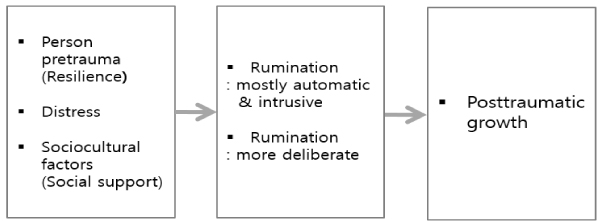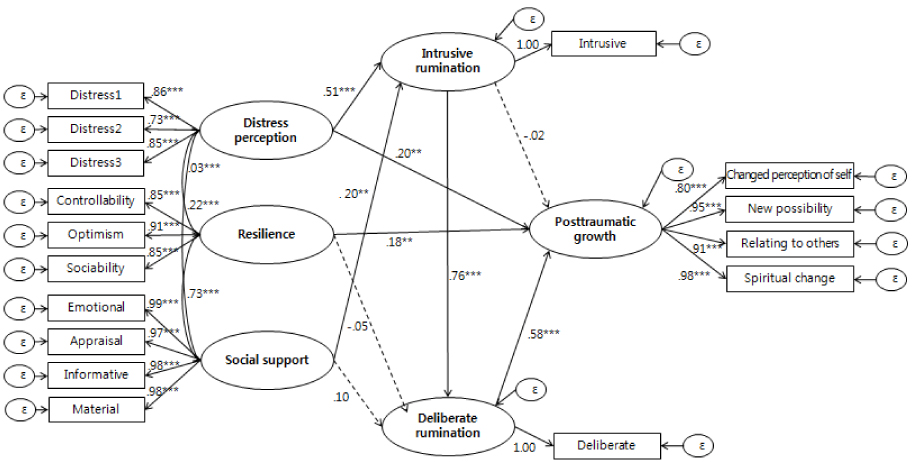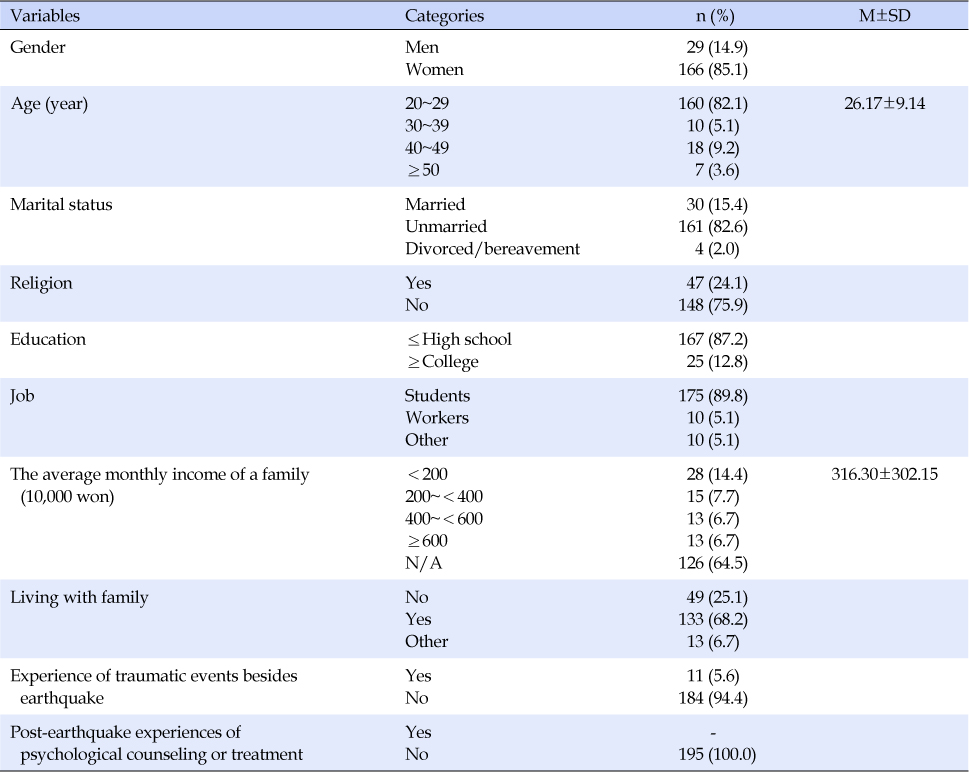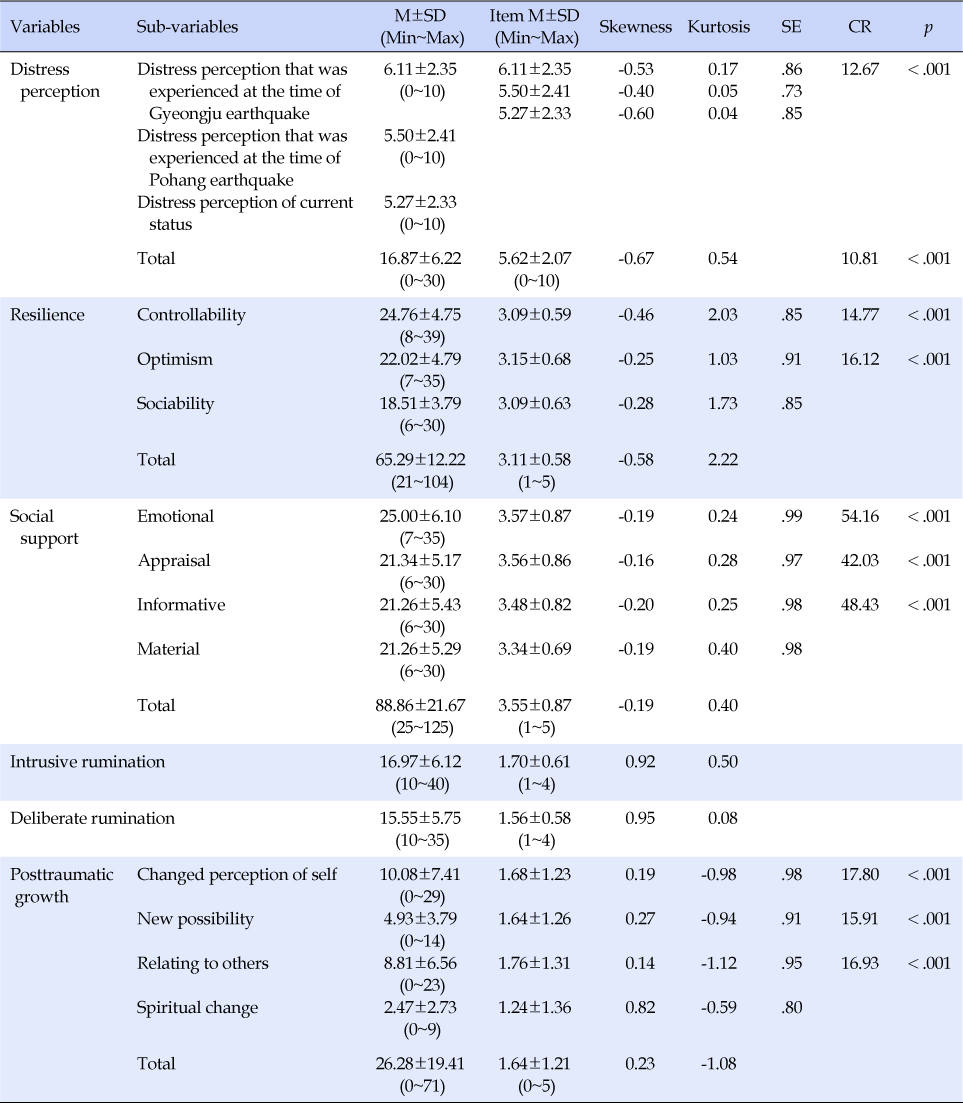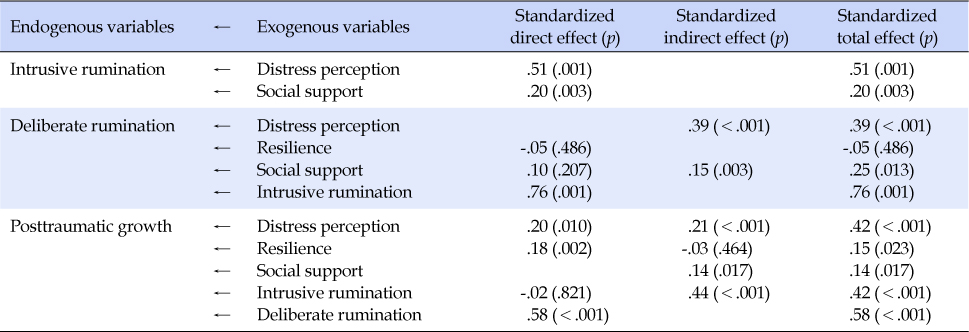References
1. Yoo MR, Choi SY, Han HL, Seo YM, Noh MI. The effect of post-traumatic growth, resilience, and optimism on quality of life among the disaster Victims. Journal of Military Nursing Research 2015;33(2):1–14.
2. Uemura M, Ohira T, Yasumura S, Otsuru A, Maeda M, Harigane M, et al. Association between psychological distress and dietary intake among evacuees after the Great East Japan Earthquake in a cross-sectional study: The Fukushima Health Management Survey. BMJ Open 2016;6(7)e011534. 10.1136/bmjopen-2016-011534.
3. Choi NH, Byun JH, Han DI, IM SB. Psychological impact and depressive response of sufferers of natural disaster, a torrential downpour. Journal of Korean Academy of Psychiatric and Mental Health Nursing 2007;16(2):139–149.
5. Kim YH. A multi-dimensional approach to disaster mental health and the roles and contributions of social work field. Korean Journal of Social Welfare Studies 2011;42(4):5–34.
6. Alderman K, Turner LR, Tong , S . Assessment of the health impacts of the 2011 summer floods in Brisbane. Disaster Medicine and Public Health Preparedness 2013;7(4):380–386.
10.1017/dmp.2013.42.
7. Goto T, Wilson JP, Kahana B, Slane S. The Miyake Island volcano disaster in Japan: Loss, uncertainty, and relocation as predictors of PTSD and depression. Journal of Applied Social Psychology 2006;36(8):2001–2026.
10.1111/j.0021-9029.2006.00091.x.
8. Song SS, Kim KH, Kwon SJ, Lee HS. Reliability and validity of a Korean version of the posttraumatic growth inventory In : 2006 Annual Conference of Korean Psychological Association; 2006 August 18–19; Seoul National University. Seoul: Korean Journal of Psychology; 2006. 08. p. 695.
9. Kwak M, Bae J. Posttraumatic growth and related factors in firefighters. Journal of Korean Academy of Psychiatric and Mental Health Nursing 2017;26(2):124–133.
10.12934/jkpmhn.2017.26.2.124.
10. Calhoun LG, Tedeschi RG. Target article: “Posttraumatic growth: Conceptual foundations and empirical evidence”. Psychological Inquiry: An International Journal for the Advancement of Psychological Theory 2004;15(1):1–18.
10.1207/s15327965pli1501_01.
11. Kim MY. Posttraumatic growth characteristics and distress in mothers of children with cancer. Asian Oncology Nursing 2015;15(4):239–245.
12. Kim BR, Shin HC. The influence of ego-resilience and meaning in life on posttraumatic growth: Mediating effect of searching for meaning and presence of meaning. Korean Journal of Psychology: General 2010;22(1):117–136.
13. Kim MY, Kim KS. Influence of hope, core beliefs and social support on posttraumatic growth in mothers of chronically ill children. Journal of Korean Academy of Fundamentals of Nursing 2012;19(4):493–502.
14. Choi SM. Exploration of posttraumatic growth related variables [dissertation] Seoul: Korea University; 2008. 107.
15. Han YM. The influence of ego resilience on post-traumatic growth in single men and women who have experienced dating relationship breakup [master's thesis] Seoul: Myongji University; 2015. 1–69.
16. Bellizzi KM, Blank TO. Predicting posttraumatic growth in breast cancer survivors. Health Psychology 2006;25(1):47–56.
10.1037/0278-6133.25.1.47.
17. Cann A, Calhoun LG, Tedeschi RG, Vishnevsky T, Lindstrom CM. Assessing posttraumatic cognitive processes: The event related rumination inventory. Anxiety, Stress, and Coping 2011;24(2):137–156.
10.1080/10615806.2010.529901.
18. Linley PA, Joseph S. Positive change following trauma and adversity: A review. Journal of Traumatic Stress 2004;17(1):11–21.
19. Kim YA, Choi YK. A qualitative study for the process of posttraumatic growth-a comparison of trauma survivors‘and therapists' perspective. Korean Journal of Health Psychology 2017;22(1):199–228.
20. Yoon MS, Park EA. Posttraumatic growth among mental health social workers. Mental Health & Social Work 2011;39:61–89.
21. Lee S, Kim YJ. Posttraumatic growth of patients with breast cancer. Journal of Korean Academy of Nursing 2012;42(6):907–915.
10.4040/jkan.2012.42.6.907.
22. Shin SY, Jeong NW. The effect of meaning in life and social support on posttraumatic growth. Journal of Human Understanding and Counseling 2012;33(2):217–235.
23. Yu HJ. The mediating effect of social support and deliberate rumination in the influence of resilience and distress perception on posttraumatic growth. Korean Journal of Counseling 2014;15(1):59–85.
24. Yu JP. The concept and understanding of structural equation modeling Seoul: Hannarae Publishing Co.; 2012. p. 567.
25. Shin WY, Kim MG, Kim JH. Developing measures of resilience for Korean adolescents and testing cross, convergent, and discriminant validity. Studies on Korean Youth 2009;20(4):105–131.
26. Park JW. A study to development a scale of social support [dissertation] Seoul: Yonsei University; 1985. 127.
27. Ahn HH, Joo HS, Sim KS, Min JW. Validation of the event related rumination inventory in a Korean population. Cognitive Behavior Therapy in Korea 2013;13(1):839–854.
28. Calhoun LG, Tedeschi RG. The posttraumatic growth inventory: Measuring the positive legacy of trauma. Journal of Traumatic Stress 1996;9(3):455–471.
10.1002/jts.2490090305.
29. Eun HJ, Lee SM, Kim TH. The epidemiological study of posttraumatic stress disorder in an urban area. Journal of Korean Neuropsychiatric Association 2001;40(4):581–591.
30. Kim HS, Nam CY, Lee HJ. Effects of post traumatic growth of firefighters-focused on the D-city fire official. Korean Review of Crisis and Emergency Management 2014;10(10):103–121.

